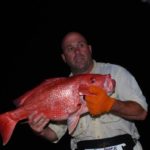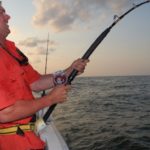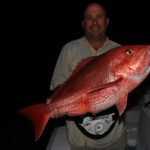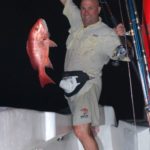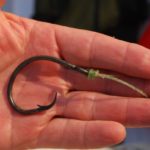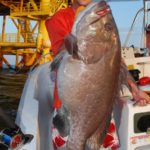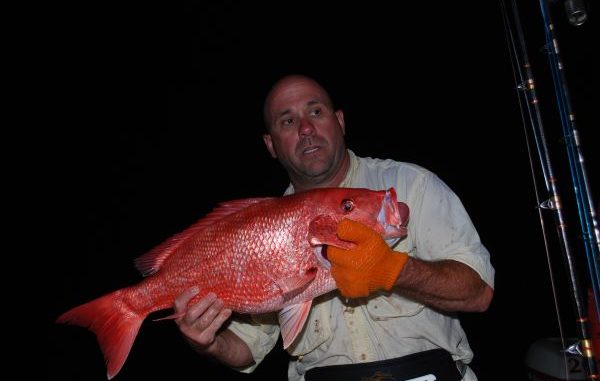
Catching big red snapper requires a different approach, and this accomplished trophy angler shares his tips.
“And they call this recreation?,” I thought to myself as the Snapper Time, a 21-foot Cape Horn, swung into a wide arc and slowed to pull up to a big yellow-legged steel oil and gas platform. Recreational means fun by most definitions.
I was a mess! The run south into the Gulf of Mexico from Caminada Pass left me completely soaked. I didn’t have a dry thread on me. My leg and thigh muscles burned from bracing myself against the vicious pounding the mean sea administered.
My back and neck ached. My innards felt like they had been jerked lose from their hangings. Even my noonies were sore from being constantly bounced up and down. For two hours and two minutes the boat, brightly wrapped in its Louisiana Fish Fry Products tattoo, had run south into a quartering southeast sea.
It was ugly. This was no place for an old man.
I asked for it. He warned me that we might fish 20 hours non-stop and that weather wasn’t likely to abort the trip. But the lure of fishing with John Langlois was too much. He has a rep as a big red snapper man.
Not a big man who catches red snappers, but a man who catches big red snappers — trophy snappers, by his definition, weigh 28 pounds or larger.
His biggest is 37 1/4 pounds, which places at No. 8 in the all-time Louisiana record books. Only it and one other fish have been added to the top 10 since 1998.
Langlois also has notched up two 33-pounders, two 32s, one 30, one 29 and a number of 28-pound fish.
The bike-looping swing that Langlois made in his approach was obvious. He was taking me to a blind side of the platform, one without a sign board that would identify its location. I stood and turned around to check his electronics to see where we were. The console door was closed. There was nothing to betray where we were.
After Austin Townsend (his 25-year-old son-in-law-to-be and fishing partner for the day) tied off the boat to the rig, I craned my neck to look up and behind him and asked him exactly where we were. His face blanched and he turned around to see what I was looking at.
His shoulders visibly relaxed when he saw that the sign board wasn’t visible. He turned and answered my question.
“Location is not really important in trophy snapper fishing,” Langlois said. “It has everything to do with equipment and fighting technique — means everything.”
I silently started making a few notes about the ride out. His eyes narrowed and he asked, not unfriendly but definitely concerned, “Whatcha writing?”
“Some notes about the trip out,” I replied.
I was still trying to get a grip on where we were.
“Well,” I asked, “can you at least tell me how deep the water is here?”
He paused a moment, then said, “Ah, I rather not say that, either.”
Hmmm. This man is incredibly secretive. But I don’t give up easily.
“What about area — not block number — just area, like “West Delta?” (We are obviously west of West Delta.)
“Yeah, yeah yeah,” he replied and waved his arm vaguely to the east. “Put West Delta. There are lots of rigs over there.”
“Okay,” I think to myself. “I know when I am beat. Let’s fish.”
I watched as he prepped. He stripped off his shirt and strapped on a fighting belt. He unsheathed a Bill Stevens custom-built rod mounted with a Shimano Tyrnos two-speed reel. Big beads of sweat popped out of the top of his shaved head and glistened on his well-toned sheetrock finisher’s body.
He looked and moved like a gladiator.
Langlois laid out the battle plan as he rigged. He was, he explained, in no hurry to catch red snappers.
“We will do that tonight,” he said. “We need to pull some mangroves out from under the rig. They don’t know that we are here yet.”
He also said that we would fish this one spot all night.
They sent down 7/0 circle hooks on 80-pound-test leaders. Later, when they would begin to target big red snappers, they would shift to 125-pound leaders and 10/0 hooks.
“Big red snappers,” Langlois said, “don’t care about line. If the bait is there, they bite it.
“Mangroves are smarter. We use 80-pound line because they will see the line.”
The 8- to 12-ounce egg sinkers threaded on their lines above the swivels on their leaders were pretty typical of what most snapper fishermen use, with one exception: The sinker was on an 18-inch piece of mono with a swivel above it as well as below it. Langlois explained that with only a single swivel below the sinker, fish can do “funny things” with the line and you can’t feel the bite.
For mangrove bait, they used halves of Spanish sardines or pieces of huge pogies cut in five chunks. Both were thawed frozen baits.
Typically, the baits were pitch-cast to near a platform leg and allowed to sink to various depths, usually within the top 50 feet of water.
The water really wasn’t that pretty, a dull green without a hint of blue. But Langlois was positive, in spite of the fact that the men didn’t catch a snapper for the first hour of fishing. Many snapper fishermen would have long ago left for another rig, but not Langlois.
“We will catch them here,” he stated with conviction. “Maybe we are between feeding periods.”
The nonexistent bite gave him plenty of time to talk about fishing for trophy red snappers.
“I like the high-speed reels that I use because I can re-bait quicker,” he said. “The more time with your bait in the water, the better your chances are of catching a big fish.
“Lots of people hang them. Some people out here use 40- or 50-poundtest line. A big fish will pull them into the rig and will lose them. When I hook a trophy, I catch it.
“A lot of people aren’t strong enough to get them up. I bring people out here — bulging muscles — football players. And they can’t get them up. They let the reels turn sideways in their hands.”
His voice showed an edge of contempt.
Finally, at 5:15 p.m., Langlois connected on a smallish mangrove. A few minutes later, he boated another larger one.
He constantly experimented, not just with depth but with baits. He cut just the head and tail off a pogy and hooked on the hand-sized chunk; he added half of a Spanish sardine to a pogy piece. When he caught a ribbon fish, he cut it up and used it for bait.
He tied a Sidewinder-type gold spoon on rod and reel spooled with 40-pound line and jigged up some hardtails. He whacked off the fillets, impaled one on a 10/0 hook and sent it to the bottom, obviously for a red snapper.
“A lot of people like to use live hardtails for big snapper,” he explained, “but there are so many amberjack here to intercept them.”
Both men were now catching mangrove snappers, but they are getting a lot more bites that they can’t hook. Contrary to “book recommendations” for using circle hooks, both men viciously struck to set the hook if they felt that the fish had the bait firmly in its mouth.
Even on the slow bite, mangrove snappers steadily came over the gunnel, the largest of which showed 9 pounds on the Boca Grip.
Almost apologetically, Langlois promised, “They’ll bite; you’ll see.”
Then, he announced change could be in the air.
“I think that I just had a [red] snapper bite,” Langlois said. “They don’t pick; they pull. They hook themselves.”
“They don’t stop,” chimed in Townsend.
The young man normally fished in silence, which balanced Langlois’ narrations.
“Big sows,” said Langlois almost respectfully, “are a bad ass beast to themselves.”
But this one wasn’t. It was only a 5-pounder, which he scornfully called a baby and returned to the water after venting it.
Both men converted to bigger hooks and bigger baits, and went to the bottom looking for more red ones.
Townsend connected on a heavier fish, and Langlois began coaching him immediately.
“Keep reeling; keep reeling; keep pumping,” he said. “Don’t let it go down.”
After the 14-pound fish was unceremoniously released, Townsend leaned against the rail, seeming exhausted.
“That was tough! If I have to do that all night, I ain’t gonna make it,” he said.
“A big one will put you to the floor,” agreed Langlois in such a way as to let Townsend know that this fish wasn’t that big. “Then you will get up, not being able to wait to catch another one.”
Townsend looked unconvinced.
Then Langlois got a chance to demonstrate his fighting technique. He slapped the rod butt into his fighting belt, sunk into a wide-legged fighter’s stance, threw his body into a powerful arch, and pumped and reeled so furiously that the 15-plus-pound fish never had a chance.
It too went back overboard.
By 7 p.m., they are catching red snappers that others would be proud to keep — and tossing them all.
“I like to start keeping them at 28 pounds,” Langlois muttered.
It seemed like a tall order to me. Are they really going to keep releasing 15-pound fish all night?
Townsend got a solid hook-up. He grit his teeth, and the veins popped out of his neck and temple as he struggled to break the stubborn fish off the bottom and horse him to the surface. It looked like a good one, but turned out to be a chunky warsaw grouper.
That one went into the box.
Meanwhile, back at the ranch, Langlois hotlined three more red snapper over 10 pounds each to the surface, unhooked them and sent them back to grow up.
Sunset charged up Langlois.
“Alright; my favorite time to fish,” he semi-hissed in sotto voce. It sounded like something Count Dracula would say as he crawled out of his coffin.
Then the bite shut down, just like that. The two warriors stopped for 20 minutes to eat a sandwich and drink a soda.
Nine o’clock found both men back on their feet fishing. Nothing bit until Townsend’s bait got hammered. The wildly fighting fish caused Langlois to suspect a shark — and it was a 7-foot hammerhead.
“Wow,” I thought. “The kid is getting all the bruisers. I wonder how much longer he can hold up.”
The fishing was still excruciatingly slow, and the few they caught were “scrubby” 5- to 7-pounders.
“Okay,” croaked Langlois, in evident self-encouragement, “I’m ready to see the rod tip hit the water and hear the drag go ‘zeek, zeek, zeek.’ That’s what I’m talking about.”
By 10 p.m. the world seemed to have shrunk to the yellowish halo of light from the platform that bathed the boat. The steady hum of the steel spider’s compressors was lulling.
And the fish still weren’t biting.
A punch-drunk Townsend stowed his rod and flopped on top of a bean bag chair. He semi-coherently murmured, “It really takes a lot out of you,” as his eyelids slipped shut.
But the vigorous Langlois was still going strong, grunting in frustration at every missed bite.
At 10:30 p.m., something big broke the line off at the rod tip. As he re-rigged, he related a story of when he was trying braided line for the first time. He broke off of fish eight times before midnight. He re-spooled with mono and the next fish was a 32-pounder.
He said he believes monofilament is the best line because it has some stretch.
“You need stretch to fight these big fish,” Langlois said.
At 10:50 p.m. he finally caught a snapper, a 10-pounder that he promptly tossed back in the drink.
“Is he willing to go home with no snapper after spending hundreds on fuel?” I thought to myself.
No more bites — none! At midnight, the witching hour, he declared his commitment.
“I am just getting warmed up,” Langlois said.
I wondered.
Then at 12:30 a.m., magic happened.
Red snapper began biting furiously. The thud of big bodies hitting the deck roused Townsend, who promptly joined the fracas.
By 2 a.m. they were catching red snapper at all depths, from 70 feet to 225 feet.
I had long ago lost count. It seemed like they had released hundreds of big red snapper, even though the count was probably only in the scores.
The box count on red snappers was still zero.
“We are killing them,” Langlois cried. “It’s one after another, but they are all under 20 pounds.”
At slightly before 4 a.m., a 20-pounder came over the rail. Langlois relented, and this one went on ice.
It was quickly followed by its twin.
At 4:20 a.m., Langlois finally showed his first signs of fatigue.
“I must be getting tired,” he said. “The fish are feeling bigger.”
Actually, they were bigger. Many were near or at 20 pounds. Townsend wasn’t saying much. He just fished grimly and silently.
By 5 a.m. only one slot in the limit was left to be filled. Langlois had been holding it for the big one.
I don’t see how he can be on his feet and functioning. He has been catching bruisers for hours. How much can his 46-year-old body take?
At 5:15 a.m. the gray haze of dawn came creeping in over the sea. At 5:30 a.m., the last big snapper hit the ice, and the two men stowed their rods.
Townsend turned the platform loose and Langlois pointed the nose of the boat north for the run home.
